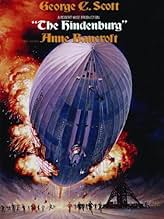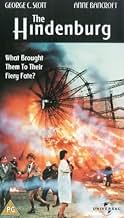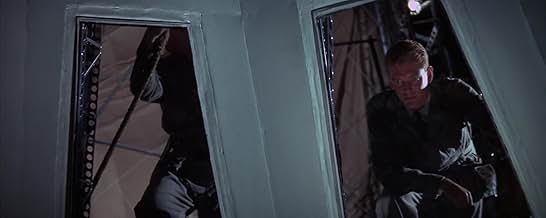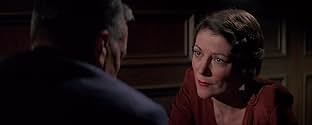PUNTUACIÓN EN IMDb
6,3/10
6,9 mil
TU PUNTUACIÓN
Crónica de la catástrofe del Hindenburg, en la que un zepelín estalló en llamas.Crónica de la catástrofe del Hindenburg, en la que un zepelín estalló en llamas.Crónica de la catástrofe del Hindenburg, en la que un zepelín estalló en llamas.
- Dirección
- Guión
- Reparto principal
- Nominado para 3 premios Óscar
- 2 premios y 4 nominaciones en total
Richard Dysart
- Lehmann
- (as Richard A. Dysart)
Reseñas destacadas
The Hindenburg (1975)
** (out of 4)
If you listen to most critics, THE HINDENBURG is the worst disaster movie ever made but I personally wouldn't go that far. The film tells a somewhat fictionalized account of what happened on the mighty ship's voyage to America, which turned out to be its last. The film's main focus is a man played by George C. Scott who begins to think that there's something not right going on. THE HINDENBURG was a hit with crowds back when it was released and it won a couple Oscar's for its special effects but I don't think there's any question that there are quite a few flaws scattered throughout this thing. The key to most disaster movies is that we're introduced to the cast, we like the cast, a disaster happens and then we see the likable cast try to survive the disaster. That doesn't happen here because the disaster doesn't happen until the final minutes of the moment and everyone going into this film knows what's going to happen. This "thriller" simply doesn't have any thrills because you know the disaster is going to be the final thing and everything leading up to it is just a bunch of dialogue that really adds up to nothing. None of the stories we're told or the characters we're introduced to really mean anything because we know what we're waiting for. I'm really not sure how they could have told this story better but perhaps have the disaster happen at the middle point and then the rest of the film focus on an investigation? I'm not sure but there's just not enough drama or thrills here to sustain a 125-minute running time. The performances are pretty much what you'd expect from a film like this. Scott is certainly good in his role and we get nice support from the likes of Anne Bancroft, Charles Durning, Gig Young, Burgess Meredith and William Atherton. The special effects are quite good but director Robert Wise's choice to switch things over to B&W during the final moments was a little strange. THE HINDENBURG isn't a good movie but I think fans of the genre will at least want to watch it once.
** (out of 4)
If you listen to most critics, THE HINDENBURG is the worst disaster movie ever made but I personally wouldn't go that far. The film tells a somewhat fictionalized account of what happened on the mighty ship's voyage to America, which turned out to be its last. The film's main focus is a man played by George C. Scott who begins to think that there's something not right going on. THE HINDENBURG was a hit with crowds back when it was released and it won a couple Oscar's for its special effects but I don't think there's any question that there are quite a few flaws scattered throughout this thing. The key to most disaster movies is that we're introduced to the cast, we like the cast, a disaster happens and then we see the likable cast try to survive the disaster. That doesn't happen here because the disaster doesn't happen until the final minutes of the moment and everyone going into this film knows what's going to happen. This "thriller" simply doesn't have any thrills because you know the disaster is going to be the final thing and everything leading up to it is just a bunch of dialogue that really adds up to nothing. None of the stories we're told or the characters we're introduced to really mean anything because we know what we're waiting for. I'm really not sure how they could have told this story better but perhaps have the disaster happen at the middle point and then the rest of the film focus on an investigation? I'm not sure but there's just not enough drama or thrills here to sustain a 125-minute running time. The performances are pretty much what you'd expect from a film like this. Scott is certainly good in his role and we get nice support from the likes of Anne Bancroft, Charles Durning, Gig Young, Burgess Meredith and William Atherton. The special effects are quite good but director Robert Wise's choice to switch things over to B&W during the final moments was a little strange. THE HINDENBURG isn't a good movie but I think fans of the genre will at least want to watch it once.
If a film about The Hindenburg had to be made it certainly would have been made in the decade of the disaster film, the Seventies. But this film labored under a unique handicap that none of the other disaster films of the decade had.
Unlike the sinking of the Titanic or the blowing up of Mount Krakatoa and certainly not like any of the potential but fictional disaster events that were film subjects, The Hindenburg was recorded on sight with newsreel cameras and on radio with Herbert Morrison's never to be forgotten broadcast. A lot of people now still remember it, let alone back in 1975.
What Robert Wise did and maybe more successfully than any other director was make full use of the famous newsreel footage and carefully edited it into his film, with slow motion techniques into the personal attempts by the cast to try and escape the holocaust. The Hindenburg received Oscar nominations for sound, cinematography, and art&set design with a special award for special effects. Yet no nomination for editing which the main plus this film has going for it.
Of course we don't know what ever really happened to the Hindenburg and the film takes account of all the theories put forth. It also uses the real names of the people who were passengers, crew, and officials of the Third Reich. The Nazi government had a big stake in the dirigible fleet they had built, they were as much propaganda value for them as Max Schmeling in boxing and Gottfried Von Cramm in tennis.
Of course had they had access to helium to float the big guys this might never have happened. But the USA had a near total monopoly on the world's helium and was not selling it to Hitler. Hence they used the lighter, but flammable hydrogen with the result of the tragedy.
George C. Scott and Anne Bancroft head the cast as a Luftwaffe official and a worldly old world countess traveling to the USA to visit her deaf mute daughter going to school for same in Boston. The Nazis didn't believe in helping those they considered defectives, another lovable quality about them.
The Hindenburg is a sobering and near factual account of what happened in Lakehurst, New Jersey that afternoon. It's one of the best of the Seventies disaster films and should not be missed.
Unlike the sinking of the Titanic or the blowing up of Mount Krakatoa and certainly not like any of the potential but fictional disaster events that were film subjects, The Hindenburg was recorded on sight with newsreel cameras and on radio with Herbert Morrison's never to be forgotten broadcast. A lot of people now still remember it, let alone back in 1975.
What Robert Wise did and maybe more successfully than any other director was make full use of the famous newsreel footage and carefully edited it into his film, with slow motion techniques into the personal attempts by the cast to try and escape the holocaust. The Hindenburg received Oscar nominations for sound, cinematography, and art&set design with a special award for special effects. Yet no nomination for editing which the main plus this film has going for it.
Of course we don't know what ever really happened to the Hindenburg and the film takes account of all the theories put forth. It also uses the real names of the people who were passengers, crew, and officials of the Third Reich. The Nazi government had a big stake in the dirigible fleet they had built, they were as much propaganda value for them as Max Schmeling in boxing and Gottfried Von Cramm in tennis.
Of course had they had access to helium to float the big guys this might never have happened. But the USA had a near total monopoly on the world's helium and was not selling it to Hitler. Hence they used the lighter, but flammable hydrogen with the result of the tragedy.
George C. Scott and Anne Bancroft head the cast as a Luftwaffe official and a worldly old world countess traveling to the USA to visit her deaf mute daughter going to school for same in Boston. The Nazis didn't believe in helping those they considered defectives, another lovable quality about them.
The Hindenburg is a sobering and near factual account of what happened in Lakehurst, New Jersey that afternoon. It's one of the best of the Seventies disaster films and should not be missed.
This is very much a niche film--one that will appeal to some viewers but probably not most. I was attracted to it for two reasons--my love of George C. Scott films as well as because I am a huge airship lover and have always wondered what it would have been like to ride in one of these behemoths. However, given that most people DON'T have this fantasy and Scott is quickly becoming a forgotten name in films, I honestly can't see most people seeing or enjoying the film.
The film is a fictionalized account of the final voyage of the Hindenburg. While it is all supposition and guesswork, it is pretty exciting. Plus at the end of the film they did a nice job of integrating existing newsreel footage into the body of the movie. The acting is pretty good and the special effects excellent, but much of the spectacle is lost on television--it was amazing on the big screen.
Overall, history lovers will be happy but most others who have no idea about this event or its context will probably be left bored and confused.
The film is a fictionalized account of the final voyage of the Hindenburg. While it is all supposition and guesswork, it is pretty exciting. Plus at the end of the film they did a nice job of integrating existing newsreel footage into the body of the movie. The acting is pretty good and the special effects excellent, but much of the spectacle is lost on television--it was amazing on the big screen.
Overall, history lovers will be happy but most others who have no idea about this event or its context will probably be left bored and confused.
The 1970's were the age of the disaster films. Films featuring man made and natural calamaties with flashy special effects and big name stars were the "in" thing back then. Irwin Allen was the master of these when he made The Posiedon Adventure and The Towering Inferno. Jennings Lang also made an epic disaster film with Earthquake. In 1975, Robert Wise got into the act with The Hindenburg. Wise is one of our finest directors and I was so happy when he won the American Film Institute's Lifetime Achievement Award several years ago. Everyone loves a good mystery and the Hindenburg disaster is certainly one of them. What caused the explosion? We will probably never know. What we do know is that politics had a lot to do with it. The Hindenburg was filled with volatile hydrogen gas instead of helium. Helium is so safe it would actually smother fire. The American government did not wish to give the Germans helium because they feared they would use it for military purposes. This film has a first class cast with George C. Scott leading the way as the heroic Colonel Franz Ritter. Only a fine actor like Scott could have made a Nazi likeable. There are so many other fine thespians in the cast like Anne Bancroft and Charles Durning (as the Captain). A very fine character actor named William Atherton is the rigger who plants the bomb. Wise is a master of suspense because we all know what is going to happen and the ship is going to blow up, and yet you are on the edge of your seat as Ritter desperately races time to find the bomb. I would also like to mention how much I enjoyed Wise's masterful use of actual film footage of the disaster which he intermingles with scenes of the various actors trying to escape the burning ship. One of the fun things about these disaster films is watching who lived and who died at the end (what is really funny is that those near the top of the cast usually lived the longest!). There was indeed a theory that a rigger on the airship named Eric Spehl (they called him Karl Boerth in the movie) had indeed sabotaged the Hindenburg. The surviving crew members said that they had heard a sudden pop over their heads and looked up to see a circle of bright light that looked like a flashbulb igniting. It was near the axial gangway and this rigger was one of only a few who had acess to it. Spehl was known to have anti Nazi views. Did he plant a bomb? The theory is that Spehl had timed his explosive device (really a flashbulb attached to a photographic timer) to go off after the airship had landed. But the landing was delayed by a storm and he could not get back in time to re set it. Spehl was killed in the disaster and thus we will never know. The most chilling part of this film is where they play Herb Morrisons recording. He was the WLS Chicago reporter who was there to witness a routine airship landing and instead it was one of the most famous recordings ever made. Morrison lived until 1988 and resided near my home in West Virginia.
Even the presence of someone like GEORGE C. SCOTT can't save THE HINDENBERG from being a less than extraordinary recreation of the famous tragedy at Lakehurst, N.J. when the German dirigible fueled by hydrogen caught fire during its landing during a lightning storm.
The most compelling footage comes toward the end of the film, when the craft is about to land and we know the unthinkable is about to happen. The special effects (designed by Alfred Whitlock) are especially strong here and combined with actual black and white footage of the event, it is mind boggling to watch. Ironically, the craft was so close to landing, with men on the ground already holding onto the landing ropes to secure the craft for its safe approach.
Unfortunately, the script Robert Wise directs is sub-par as far as interest in the characters. I'd be tempted to call it "Grand Hotel in the Sky" but there's not even enough soap-opera element to the cast of passengers that make any of them memorable, including ANNE BANCROFT, as a Countess, GIG YOUNG and BURGESS MEREDITH.
The plot is mostly fiction about a crew member causing a bomb to explode and ignite the huge aircraft, not really substantiated by the known facts although it makes for a compelling story. Historically correct or not, it's a film worth seeing but don't expect a disaster film comparable to THE TOWERING INFERNO or TITANIC.
What's really fascinating is seeing what the inside of the dirigible is like for passenger travel, truly elegant and comfortable...a reminder of the sort of elegance that greeted those aboard the TITANIC.
The most compelling footage comes toward the end of the film, when the craft is about to land and we know the unthinkable is about to happen. The special effects (designed by Alfred Whitlock) are especially strong here and combined with actual black and white footage of the event, it is mind boggling to watch. Ironically, the craft was so close to landing, with men on the ground already holding onto the landing ropes to secure the craft for its safe approach.
Unfortunately, the script Robert Wise directs is sub-par as far as interest in the characters. I'd be tempted to call it "Grand Hotel in the Sky" but there's not even enough soap-opera element to the cast of passengers that make any of them memorable, including ANNE BANCROFT, as a Countess, GIG YOUNG and BURGESS MEREDITH.
The plot is mostly fiction about a crew member causing a bomb to explode and ignite the huge aircraft, not really substantiated by the known facts although it makes for a compelling story. Historically correct or not, it's a film worth seeing but don't expect a disaster film comparable to THE TOWERING INFERNO or TITANIC.
What's really fascinating is seeing what the inside of the dirigible is like for passenger travel, truly elegant and comfortable...a reminder of the sort of elegance that greeted those aboard the TITANIC.
¿Sabías que...?
- CuriosidadesThe actual site of the Hindenburg crash, at Lakehurst Naval Air Station (now part of Joint Base Lakehurst-Dix-McGuire) is marked with a chain-outlined pad and bronze plaque where the airship's gondola landed. It was dedicated on May 6, 1987, the 50th anniversary of the disaster. Hangar #1, which still stands, is where the airship was to be housed after landing. It was designated a National Historic Landmark in 1968.
- PifiasThe incident depicting the Hindenburg's crew repairing the tear in the Zeppelin's cover as it drifts lower and lower over the Atlantic is factual; however, the event occurred on the Graf Zeppelin, not the Hindenburg.
- Citas
Mrs. Channing: Sugar, next time, let's take the Titanic.
- Créditos adicionalesThe film opens with the 1936 Universal logo followed by a newsreel prior to the credits.
- Versiones alternativasDeleted scenes were added back into the film for television airings, including one in which Goebbels shows Ritter a display of items used in attempted anti-Nazi attacks, including a bomb found on board the ocean liner "Bremen".
- ConexionesEdited into En busca del arca perdida (1981)
- Banda sonoraThere's a Lot To Be Said for the Fuehrer
Music by David Shire
Lyric by Ed Kleban (as Edward Kleban)
Performed by Peter Donat (uncredited), Robert Clary (uncredited)
Selecciones populares
Inicia sesión para calificar y añadir a tu lista para recibir recomendaciones personalizadas
- How long is The Hindenburg?Con tecnología de Alexa
Detalles
- Fecha de lanzamiento
- País de origen
- Idioma
- Títulos en diferentes países
- The Hindenburg
- Localizaciones del rodaje
- Marine Corps Air Station Tustin, Tustin, California, Estados Unidos(used for Naval Air Station Lakehurst - airship hangers still standing in 2022)
- Empresa productora
- Ver más compañías en los créditos en IMDbPro
Taquilla
- Presupuesto
- 15.000.000 US$ (estimación)
- Duración2 horas 5 minutos
- Color
- Relación de aspecto
- 2.35 : 1
Contribuir a esta página
Sugerir un cambio o añadir el contenido que falta

Principal laguna de datos
By what name was Hindenburg (1975) officially released in India in English?
Responde




































